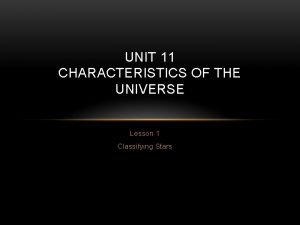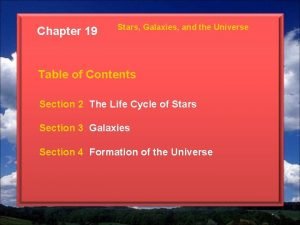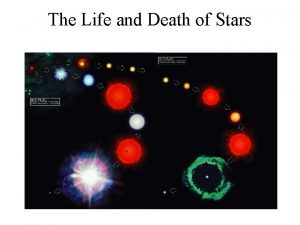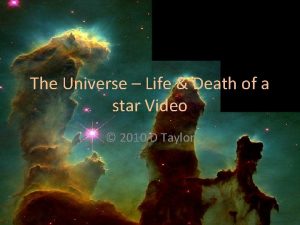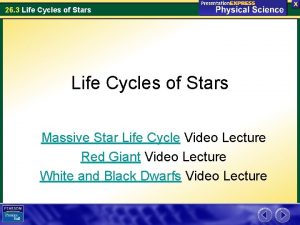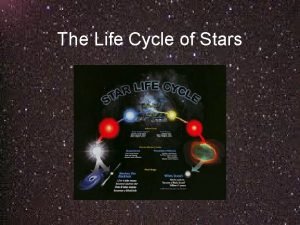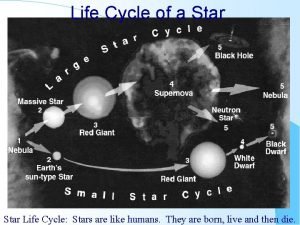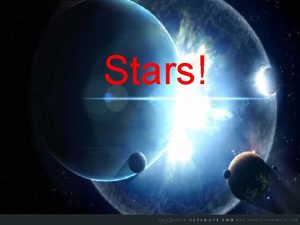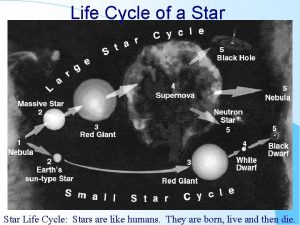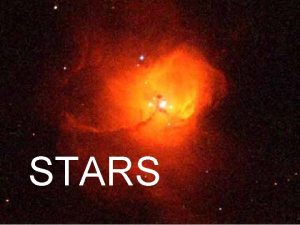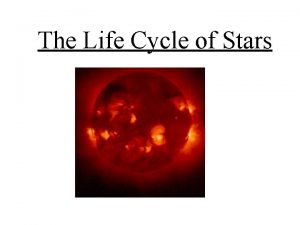Life Cycle of Stars Lesson 4 Unit 2













- Slides: 13

Life Cycle of Stars Lesson 4, Unit 2

Life Cycle Video (Relax, but pay attention)

Life Cycle • Astronomers can’t watch a single star for billions of years so they study many stars in different stages of the stars’ life cycles to see how they differ from one another. • Each star is born, goes through its life cycle, and dies.

Early stages • A nebula is a large cloud of gas and dust spread out in an immense volume. • Gravity can pull some of the gas and dust in a nebula together. • A protostar is a contracting cloud in the earliest stage of a star’s life. • A star is born when the contracting gas and dust from a nebula become so dense and hot that nuclear fusion starts.

Life Expectancy • How long a star lives depends on its mass. • Small-mass stars use their fuel more slowly than largemass stars, so they have much longer lives.

Running on “E” • When a star begins to run out of hydrogen fuel, the star becomes a red giant or supergiant. • When a star runs out of fuel, it becomes a white dwarf, a neutron star, or a black hole.

Small or Medium Mass star • A red giant is when small-mass or medium-mass stars use up their fuel, their outer layers expand.

Small or Medium Mass star • Eventually, the outer parts grow bigger and drift into space, forming a cloud of gas called a planetary nebula.

Small or Medium Mass star • The blue-white hot core of the star that is left behind cools and becomes a white dwarf.

Giant and Super Giant stars • A supernova is a dying giant or supergiant star that suddenly explodes. • After the star explodes, some of the materials from the star are left behind.

Giant and Super Giant stars • This material may form a neutron star. • Neutron stars are the remains of high-mass stars. • They are even smaller and denser than white dwarfs.

Pulsars • In 1967, Jocelyn Bell found an object in space that appeared to give off regular pulses of radio waves. • Astronomers soon discovered that the source of the radio waves was a rapidly spinning neutron star. • Spinning neutron stars are called pulsars, short for pulsating radio sources.

Supermassive Stars • The most massive stars become black holes when they die. • After a large mass star explodes, a large amount of mass may remain. • The gravity of the mass is so strong that gas is pulled inward, pulling more gas into a smaller and smaller space. • Eventually, the gravity becomes so strong that nothing can escape, not even light.
 The stars there are millions of stars in the sky
The stars there are millions of stars in the sky Life cycle of medium mass star
Life cycle of medium mass star Life cycle of stars
Life cycle of stars H
H Life cycle of stars graphic organizer
Life cycle of stars graphic organizer Chapter 19 section 2 the life cycle of stars answer key
Chapter 19 section 2 the life cycle of stars answer key Life cycle of stars poster
Life cycle of stars poster Lindamood bell seeing stars lesson plans
Lindamood bell seeing stars lesson plans The life and death of stars
The life and death of stars The life and death of a star
The life and death of a star Section 26.3 life cycles of stars
Section 26.3 life cycles of stars What is charted on an hr diagram
What is charted on an hr diagram Gigline jrotc
Gigline jrotc Hyp opp adj
Hyp opp adj




